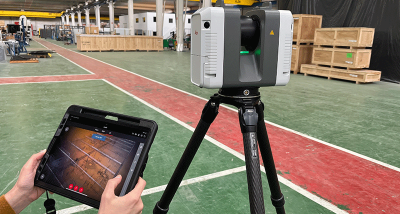Highlights:
- Lanmar Services tested the software’s ability to extract geometry from point clouds while working on a project for NASA
- Lanmar was able to model a building with a complex sled system in under five hours
- Sequoia excels with complex shapes like overhangs and onion domes–saving hours, or even days of modeling effort
Lanmar Services has found great value in Sequoia from Thinkbox Software to help translate point data into more recognizable objects.
Texas-based Lanmar connects the dots for clients, using laser scanners to record and translate 3D structural data from existing buildings into functional, precise 2D CAD or 3D building information models (BIM). With 360-degree views and the ability to document 250,000 points per second, laser scanners offer a more efficient and accurate measurement method than traditional surveying, and can easily document dangerous or hard-to-reach areas without risk.
Larry Kleinkemper, Lanmar’s corporate technology officer and lead modeler, began testing Sequoia while it was in beta, putting it to work on a project for NASA documenting buildings from the space shuttle program for historical reference. Kleinkemper and his team were tasked with creating detailed notes on each building’s function, along with its interior and exterior appearance.
Using Sequoia proved to be a significant timesaver, streamlining the conversion of 3D scan data to geometry across the board. In modeling a building that housed a complex sled system designed to test different landing struts and gears, Kleinkemper was able to shape a perfect visualization using Sequoia in less than five hours, including clean up — a process that took approximately 41 hours prior to adopting Sequoia.
“Sequoia was amazing at handling this complex structure that had pipes crisscrossing and jutting out in every direction,” Kleinkemper says. “It significantly reduced the time it takes to get a model out of a point cloud. Plus, Sequoia handled overhangs with no problem, whereas they are too complicated with other auto-extraction programs and we have no choice but to go in and model them manually. With Sequoia, it’s like a whole new way of working.”
Based on the success of the NASA project, Kleinkemper has since integrated Sequoia into his standard workflow at Lanmar. He uses 3D scanner data and extracts geometry within Sequoia or ClearEdge 3D’s Edgewise, and then sends the geometry to Autodesk Revit or AutoCAD for modeling and often also to Autodesk 3Ds Max for rendering and animation. He has found Sequoia to be particularly useful for tackling challenging architectural details, such as onion domes or entryway lion sculptures.
“Specialty shapes are no match for Sequoia,” Kleinkemper says. “If we didn’t have the software, we’d spend hours or even weeks modeling those elements manually. We’ve been blown away by Sequoia so far and definitely plan to continue expanding its role here at Lanmar.”












